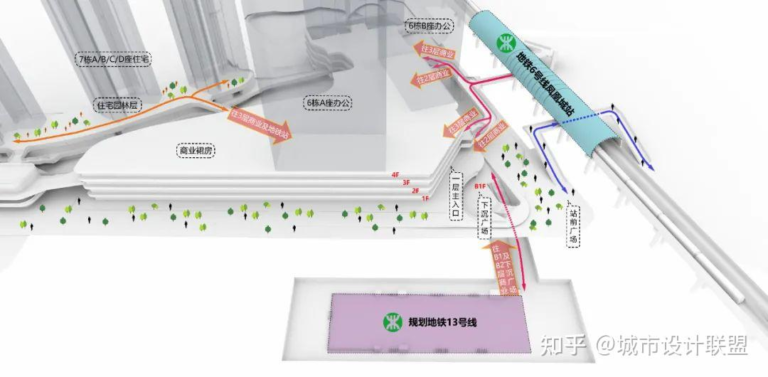Why TOD is important in Newcastle
Introduction
Whenever I walk through the area around Newcastle’s Central Station, it’s buzzing with life. Shops, people, and public spaces naturally cluster around it
TOD is not a new thing. Many cities around the world have been using this model in recent decades. It is a public transportation-oriented development model that focuses on the hustle and bustle of the station area.
China Case: Qianhai, Shenzhen

Figure 1. Concept rendering of Shenzhen Qianhai underground TOD system.
Source: Zhihu Column, 2023.

Figure 2. Urban design rendering of the Meilinguan TOD redevelopment project.
Source: Zhihu Column, 2023.
A typical example is Qianhai District in Shenzhen, which has mostly used the TOD model and was built almost overnight. It is centered around the subway line, and there are many shopping malls gathered at each subway station. The transportation here is also very convenient, but it feels boring to walk, and the area is empty after get off work. It seems that the community is designed for passers-by rather than for people living here. Qianhai’s TOD is more like a business plan rather than a lifestyle.
European Case: Rotterdam Central Station
Rotterdam Central Station, its bicycle lanes are relatively well integrated with the surrounding streets and squares. The commuters and residents here communicate frequently, it is very lively, and the environment is very humane. There are many shops and cafes in this area, forming a very warm and hospitable community.
Thinking about TOD
China’s TOD model is rapidly evolving, but its future depends on shifting from simply “building stations” to truly “building life.” This means strengthening slow-mobility systems like walking and cycling, controlling development density to avoid overwhelming urban spaces, improving the quality of spatial experience, and achieving genuine station-city integration. TOD should not just be about railways and high-rise buildings — it must be a people-oriented approach to reimagining how cities grow, connect, and live.
Newcastle has a relatively long history. We cannot build from scratch like Shenzhen, and at the same time ensure historical care and humanistic care, but we can also use this TOD concept, which means adding more residences and shops near subway stations and train stations, and this area has more slow-moving, systems and pedestrian-friendly, making it more suitable for walking and cycling. By learning from Shenzhen’s ambitions and entering Rotterdam’s humane choices, we can not only make transportation more convenient in a public way, but also make daily life more convenient. For example, when people transfer from subways to trains, there are more businesses inside these transportation hubs such as subway stations. People have a way to kill time inside the subway station during the transfer waiting period, such as within an hour or two hours. Help our city to be more sustainable and maintain its original characteristics.
reference
- Qianhai Authority of Shenzhen. TOD: Shaping a New Urban Pattern for Shenzhen [online]. Available at: https://qh.sz.gov.cn/sygnan/qhzx/dtzx/content/post_10983777.html [Accessed 22 Mar. 2025].
- Southcn.com. (2024). Qianhai’s “Metro+” Urban Renewal Pilot Project Launched [online]. Available at: https://pc.nfnews.com/11831/5849516.html [Accessed 22 Mar. 2025].
- Shenzhen News. (2025). Qianhai Builds a High-Level Modern Comprehensive Transportation System [online]. Available at: https://www.sznews.com/news/content/mb/2025-01/11/content_31433983.html [Accessed 22 Mar. 2025].
- Zhihu Column. (2023). Why Is Shenzhen Suitable for TOD? [online]. Available at: https://zhuanlan.zhihu.com/p/631580039 [Accessed 22 Mar. 2025].





I really appreciate the comparison you made in the article between the two TOD cases in China and Europe. This makes your analysis both realistic and international in perspective. You didn’t simply say which one is better, but compared the efficiency-oriented model of Qianhai with the more people-oriented street space of Rotterdam, presenting the “character differences” of TOD in different urban contexts.
I completely agree with your point that Newcastle “cannot start from scratch like Shenzhen”. Our city has a lot of historical layers and its spatial layout has already been formed. Therefore, in this case, TOD should not pursue “speed” or “scale”, but rather focus on improving the pedestrian system, connecting old functions with new developments, and reactivating public spaces.
The detail you mentioned at the end, “being able to do some shopping while waiting for the transfer”, was particularly realistic. I myself have had the same experience. A well-designed station commercial area can truly turn the boring waiting time into a part of life. This made me realize again: Design is not just infrastructure, but something centered around people’s lives. I’m looking forward to seeing you turn these ideas into a specific site sketch or space plan in the future.
References
1.Knowles, R.D., Ferbrache, F. & Edward Elgar Publishing, publisher (2019) Transit oriented development and sustainable cities : economics, community and methods.
2.Calthorpe, P. (1993) The next American metropolis : ecology, community, and the American dream. New York: Princeton Architectural Press.